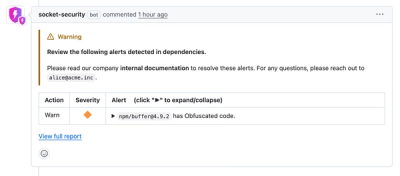
Security News
Crates.io Users Targeted by Phishing Emails
The Rust Security Response WG is warning of phishing emails from rustfoundation.dev targeting crates.io users.
Tree-based action logger and effects library
Reduxes middleware is popular and generic, but quite underpowered. Actions like making AJAX requests, connecting websockets, and setting cookies often need to be asynchronous. While you can do certainly do these things in Redux's middleware, it's flow is mind-bending because Redux's middleware is synchronous, so you need to internally re-dispatch to achieve asynchronous behavior.
Let's take some of the lessons we learned on the server with asynchronous http frameworks like Koa and make them compatible on the wider web using Promises. This will give us more powerful middleware to work with in the browser.
const Alley = require('alley')
const { send, use } = Alley()
// root middleware for things like logging
use(async (action, next) => {
console.log('->', action.type, action.payload)
await next()
console.log('<-', action.type, action.payload)
})
// any sort of http request specifc logging, timing, etc.
use('http', async (action, next) => {
console.time('request')
await next()
console.timeEnd('request')
})
// perform a POST request
use('http:post', async (action, next) => {
// ...
})
// perform a GET request
use('http:get', async (action, next) => {
let res = await fetch(action.payload.url)
action.payload.response = res
await next()
})
// send an action
// steps: root -> http -> http:get -> http -> root
let action = await send('http:get', {
url: 'http://google.com'
})
npm install alley
Create an action handler with an optional namespace.
The namespaces are arranged in a tree structure, separated by colons.
Send an action down, then back up the tree. The flow is conceptionally similar to Koa, so understanding Koa's model would be a good place to start.
Send supports a couple different formats and automatically handles error types. For now, it's best to look at the tests for usage examples.
Send returns a Promise that will resolve after the flow completes or there's an error that's thrown.
npm test
MIT
FAQs
action logger and effects library
We found that alley demonstrated a not healthy version release cadence and project activity because the last version was released a year ago. It has 1 open source maintainer collaborating on the project.
Did you know?

Socket for GitHub automatically highlights issues in each pull request and monitors the health of all your open source dependencies. Discover the contents of your packages and block harmful activity before you install or update your dependencies.

Security News
The Rust Security Response WG is warning of phishing emails from rustfoundation.dev targeting crates.io users.

Product
Socket now lets you customize pull request alert headers, helping security teams share clear guidance right in PRs to speed reviews and reduce back-and-forth.

Product
Socket's Rust support is moving to Beta: all users can scan Cargo projects and generate SBOMs, including Cargo.toml-only crates, with Rust-aware supply chain checks.